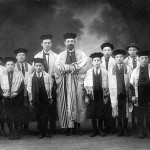Sabbath of Song – B’shallach
 The music of the Temple in ancient Jerusalem must have been remarkable.
The music of the Temple in ancient Jerusalem must have been remarkable.
The musicians were the Levites, their mode a combination of vocal and instrumental, their mood an oscillation between agony and ecstasy.
Look at the musical references in the Book of Psalms with its chorus of praise – and its chorus of lament; its meditative instruments – and its full-throated instruments of triumph and joy.
Then came the time of trauma. The Temple was destroyed. The Levite choir came to an end. No-one could sing the song of the Lord any more in a land of exile.
Musical instruments were inappropriate because there was no Temple. Even at weddings, when nothing could prevent the welling up of human emotion, the music had to be restricted.
Yet music had to have its place, and it moved into the synagogue, the home and the hall of study.
Synagogue music took three forms: Biblical cantillation, prayer chant and, eventually, choral singing.
The modes of cantillation varied depending on the Book that was being read. There were separate styles of melody for the Chumash, the haftarot and the megillot.
There were also ethnic differences between Ashkenazim and Sephardim and sub-groups within each tradition; the ethnic differences reflected the environment so that even today one can discern styles of melody that come, for example, from Germanic, Russian, Roman and Spanish backgrounds.
No-one can claim to have the original cantillation, though all follow a rhythm and pattern that must be very ancient.
The prayer chant – nussach – was also a matter of diversity in unity. There was room for variety, but each Jewish tradition had its own musical theme for each occasion.
The officiant might improvise and go off on a musical tangent, even bringing in snatches of melodies from outside, but he always returned to the standard mode.
Who was the officiant? The chazan started off as the synagogue overseer and became the resident expert in the services. Originally without musical training, he became a professional precentor, sometimes bitterly criticised for turning into a prima donna.
In many places the chazan was supported by a rudimentary choir, and eventually the choral music itself became an art form and questions arose as to how to control the composition of the choir and the conduct of the choristers.
At home it was Shabbat and festivals that brought music to the table. When the world was hostile, the Jewish family was a sanctuary. When it was cold outside, the Jewish home was warm. Songs – often incorporating snatches of popular melody from outside sources – were passed down the generations, and it was no barrier to lack a singing voice.
In the study hall a Talmudic sing-song developed. As people studied together they would dramatise the development of the rabbinic argument by raising, lowering and varying the voice. Children’s melodies for Mah Nishtanah often recapture the Talmudic melody.
All this deserves to be celebrated on Shabbat Shirah, the Sabbath of Song.



